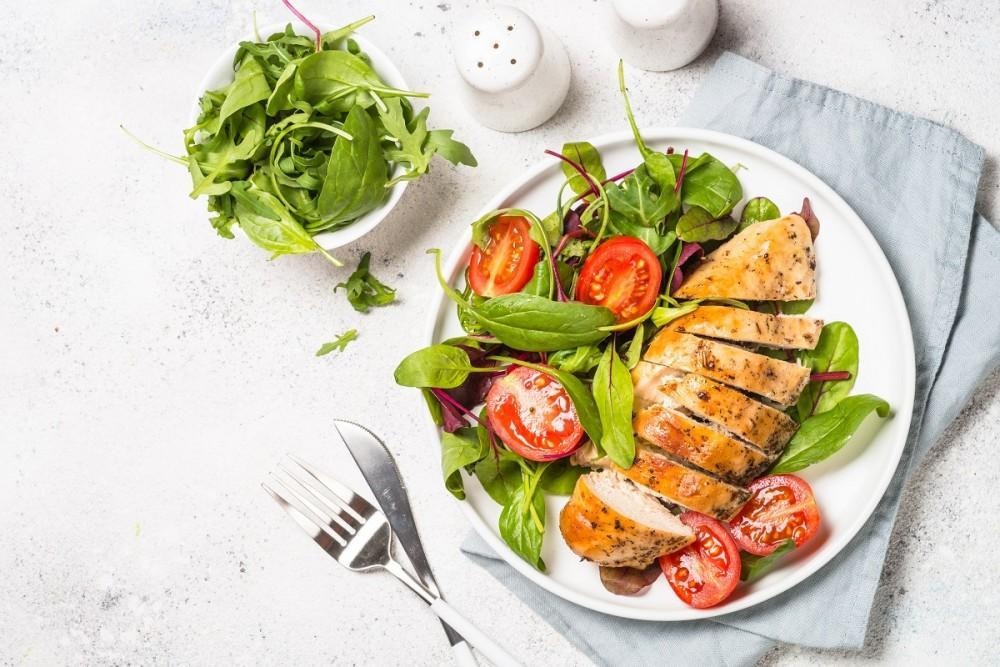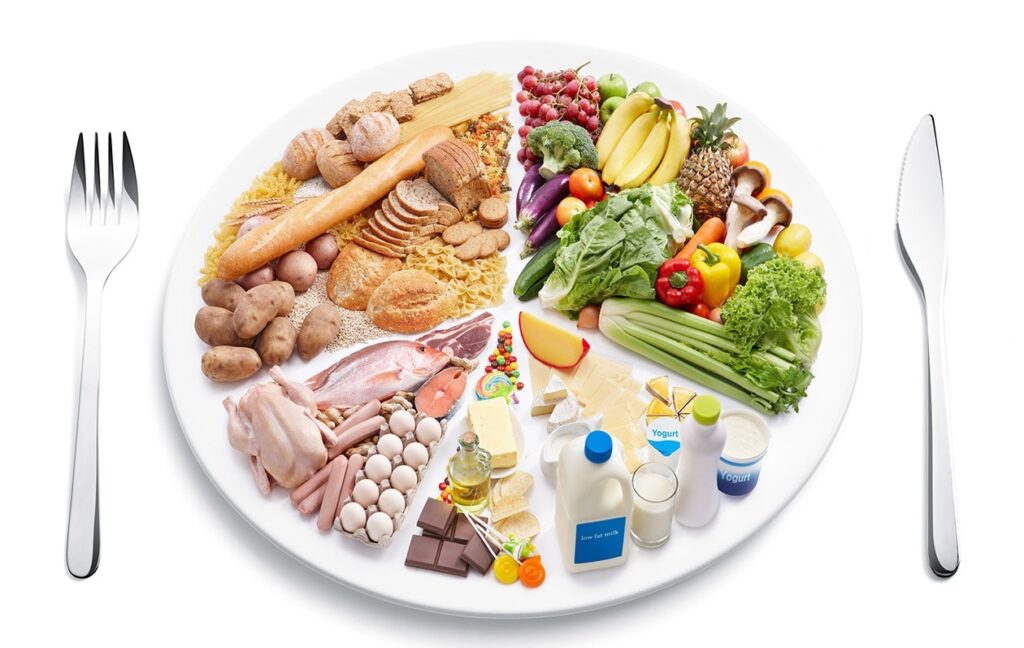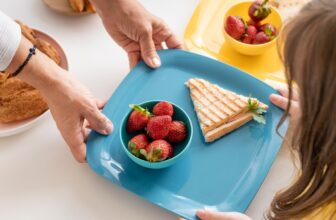
Eating well doesn’t have to feel like a full-time job. Many people give up on “healthy eating” because they think it requires strict calorie counting, weighing every bite, or knowing the exact nutrient breakdown of every food. The truth is, building a balanced meal can be simple once you understand a few core principles.
You don’t need advanced nutrition knowledge—you just need a flexible framework you can apply to almost any situation, whether you’re at home, dining out, or grabbing something quick on a busy day.
The aim is to nourish your body so you have steady energy, avoid blood sugar crashes, and feel satisfied—not stuffed—after eating. By combining the right food groups in the right proportions, you can get there without making mealtime stressful or complicated.
Key Points – Building a Balanced Meal Made Simple
- Build each plate around protein, healthy carbs, colorful produce, and fats.
- Think in terms of proportions, not exact numbers or grams.
- Use visual cues like your hand size to guide portions.
- Keep a few “go-to” meal combos for busy days.
- Flexibility beats perfection—consistency matters most.
Table of Contents
Understanding the Core Elements of a Balanced Plate

Source: alimentarium.org
At the heart of balanced eating are the macronutrients—protein, carbohydrates, and fats—and micronutrient-rich foods like vegetables and fruits. Each plays a unique role:
- Protein: More than just a muscle-builder, protein supports immune health, hormone production, and satiety. Sources can include chicken, fish, eggs, tofu, lentils, or Greek yogurt.
- Carbohydrates: The body’s preferred fuel source, especially important for active lifestyles. Whole grains, starchy vegetables, beans, and fruit offer slow-digesting carbs that keep energy steady.
- Healthy fats: Help absorb vitamins A, D, E, and K, support hormone balance, and make food taste better. Think olive oil, avocado, nuts, seeds, and fatty fish.
- Fiber: While technically part of carbs, fiber-rich foods like vegetables, legumes, and whole grains help with digestion, satiety, and blood sugar control.
Instead of obsessing over exact numbers, imagine your plate like this:
- Half filled with vegetables or fruit.
- A quarter with protein.
- A quarter with carbs.
- Fats sprinkled in or drizzled for flavor.
This visual method works just as well at home as it does when you’re choosing from a menu at a restaurant.
Let Technology Simplify the Process
If you tend to get stuck wondering if your meals are “balanced enough,” using tools like an AI food nutrition coach can help you make smarter decisions with less effort.
These tools learn your preferences, track your patterns, and recommend meal options that hit the right nutrient balance without you having to calculate anything.
For example, if you’ve had a carb-heavy breakfast, the coach might suggest a lunch that’s heavier on protein and vegetables to even things out.
Or if you log your activity level, it could recommend slightly higher carb portions on more active days. It’s a way to automate the decision-making process so you can focus on enjoying your food instead of second-guessing it.
The “Three-Plus-One” Formula for Quick, Balanced Meals

Source: lindsaypleskot.com
One of the simplest ways to keep things balanced without micromanaging your diet is to follow the Three-Plus-One formula:
- Three: Protein + Carbs + Vegetables/Fruit
- Plus One: A healthy fat
Here’s what that can look like in real life:
Breakfast Example
- Protein: Two boiled eggs
- Carbs: One slice of whole-grain toast
- Vegetables/Fruit: Sliced tomato or fresh berries
- Healthy Fat: A teaspoon of olive oil on the toast or avocado spread
Lunch Example
- Protein: Grilled chicken breast
- Carbs: Brown rice
- Vegetables: Steamed broccoli and carrots
- Healthy Fat: A drizzle of sesame oil or a small handful of cashews
Dinner Example
- Protein: Salmon fillet
- Carbs: Roasted sweet potato
- Vegetables: Mixed salad with cucumber and bell peppers
- Healthy Fat: Olive oil and lemon dressing
This method works for almost any cuisine. You could apply it to pasta, tacos, grain bowls, or even takeout meals by mentally checking if the core elements are present.
Portioning Without Measuring Tools

Source: crossfithamptonroads.com
Measuring every gram of food can be useful for athletes or those with specific health goals, but for most people, it’s overkill. Instead, try using hand-based portion cues:
- Protein: About the size and thickness of your palm (20–30g protein)
- Carbs: About the size of your cupped hand (one serving)
- Fats: About the size of your thumb (one to two servings per meal)
- Vegetables: As much as you can hold in two hands (unlimited for most non-starchy veggies)
This approach works no matter where you are—at home, a buffet, or a dinner party. It helps you avoid overeating while still feeling full and satisfied.
Balancing for Energy and Satiety
A meal can be “nutritionally balanced” on paper but still leave you feeling drained or hungry soon after. The real test is how you feel after you eat. If you get an energy crash, it could mean you had too many refined carbs without enough protein or fat to slow digestion. If you’re hungry again an hour later, you might need more protein or fiber.
For active days, you might increase your carb portion slightly for energy. On rest days, you might naturally lean toward more vegetables and protein. Learning to adjust based on your body’s feedback will make balanced eating feel more natural over time.
Making Balanced Eating a Habit

Source: ezra.com
Once you have the basic framework, the key is to make it automatic. The more you plan ahead, the less mental effort it takes in the moment.
Strategies to make it stick:
- Batch prep: Grill several chicken breasts, roast a tray of vegetables, and cook a pot of rice once or twice a week.
- Keep staples on hand: Eggs, canned beans, frozen vegetables, whole-grain wraps, and olive oil make balanced meals possible in minutes.
- Rotate favorites: Have a short list of go-to breakfasts, lunches, and dinners you can rotate to reduce decision fatigue.
- Stay flexible: Some days you’ll eat perfectly balanced meals; other days, not so much. Progress matters more than perfection.
When you combine these habits with a simple plate framework, balanced eating becomes part of your routine rather than a daily puzzle you have to solve.
Final Thoughts
Building a balanced meal without overthinking is about keeping it visual, simple, and adaptable. You don’t need to track every calorie or follow strict rules.
As long as your plate regularly includes a quality protein source, healthy carbs, colorful produce, and some fats for satiety, you’re already doing more for your health than most people.
Over time, this becomes second nature. You’ll start to notice that your meals feel complete, your energy stays steady, and you’re no longer stressing over whether you “ate right” today. That’s the kind of balance that actually lasts.







